I spent about an hour yesterday playing with geometry tiles. I was:
- Fully engaged and enjoying myself.
- Experiencing OMG, WTF, and AHA moments. (AKA actively learning.)
The inspiration for my mathematical play time was this photo from Sara Vanderwerf’s recent post on Stand and Talks, a bold routine she uses to increase the number of students talking about math. Really great stuff and worth your time to read it through.
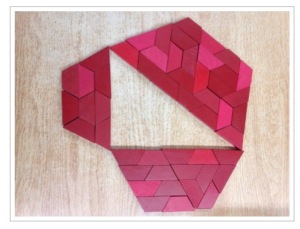 But back to the photo, which is her example of using a Stand and Talk to introduce a new idea, in this case, the Pythagorean Theroem. My eyes perk up (is that a thing?) because I have been pondering about this very topic. Specifically, wondering about what activities/tasks would place students in the active role of sense-making.
But back to the photo, which is her example of using a Stand and Talk to introduce a new idea, in this case, the Pythagorean Theroem. My eyes perk up (is that a thing?) because I have been pondering about this very topic. Specifically, wondering about what activities/tasks would place students in the active role of sense-making.
The first thing that popped into my head was….wait, trapezoids? (Thank you, Sara!) Then I started some noticin’ and wonderin’ from my teacher-y perspective and also imagining/guessing what students might say. The more I noticed and wondered, the more I realized how FULL OF MATH IDEAS this one photo is.
I find this exciting. Really, really exciting. Can you imagine starting here, with this one little image, asking students what they notice and wonder, and then letting them run with their curiosity? Isn’t it joyful to know in your heart of hearts that this is so much BETTER than, “Hey kids, here’s a little something called the PT, copy it in your journal/onto your pre-made “doodle” notes, plus copy these three examples of how to get the right answer, and do this worksheet”? How superior this single photo and all its potential are to “I do, we do, you do” and /or anything else that keeps students in the passive role?
It didn’t take me long to drag out my tub of tiles and start messing around with them. TOTALLY what I would want my students to ask beg to do.
The questions I decided to guide my play were:
First, can a proportional, scaled-up version of each polygon tile (that I have) be built with only that particular tile?
If so, why? Is there a pattern?
If not, why not?
Second, can any three similar polygons be used to make any type of triangular “hole”? Why or why not? Which ones make right triangles? Why? Is there a pattern??
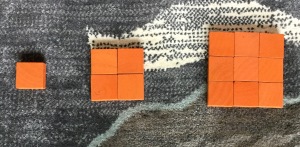
I started with squares. Don’t know why, maybe because that’s what is already familiar to me. No surprises, the areas are the square numbers, 1, 4, 9, 16…..
So I moved on to the equilateral triangles, wondering/kinda expecting that I will make triangular numbers. Imagine my surprise 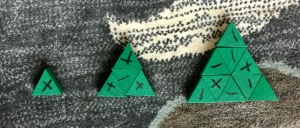 (my OMG moment) to find SQUARE NUMBERS AGAIN! Holy shit! NOT what I was expecting! Now I feel compelled to keep exploring. COMPELLED. (Imagine your students feeling compelled!!)
(my OMG moment) to find SQUARE NUMBERS AGAIN! Holy shit! NOT what I was expecting! Now I feel compelled to keep exploring. COMPELLED. (Imagine your students feeling compelled!!)
I quickly confirmed that the next in the series takes 16 triangles, and moved on to 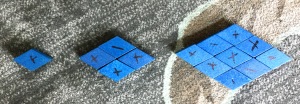 the rhombus. YES, the areas are square numbers AGAIN! Which gets me reconsidering my understanding of square numbers and forming conjectureish questions: Can square numbers be made out of any polygon, not just squares? These are all regular; what if they are irregular?
the rhombus. YES, the areas are square numbers AGAIN! Which gets me reconsidering my understanding of square numbers and forming conjectureish questions: Can square numbers be made out of any polygon, not just squares? These are all regular; what if they are irregular?
I’ve been reading Tracy Zager’s fabulous book Becoming the Math Teacher You Wish You Had. She starts Chapter 7, Mathematicians Ask Questions, with a quote from Peter Hilton: “Computation involves going from a question to an answer. Mathematics involves going from an answer to a question.” Brilliant distinction. Looks like I’m living Chapter 7. Know I want this for my students!
Remember, one photo.
I finally get to the trapezoids, which are more challenging to tile and require some analysis. I managed to construct one, but the number of tiles it took (7) was a red flag for me, so I examined it closely to verify if it was proportional or not. It wasn’t, so I kept playing, keeping these two beliefs in my mind: a proportional trapezoid was possible, and it could be made out of 4 tiles. And lo and behold….
two beliefs in my mind: a proportional trapezoid was possible, and it could be made out of 4 tiles. And lo and behold….
TA DA! “Square” Numbers! (Whew!)

By now, I have even more questions. By now, I have reviewed and applied my prior understanding of proportionality and similar figures, without ever touching a worksheet. By now, I’ve taken risks, persevered, reasoned, looked for patterns, used vocabulary, formed conjectures, and justified. All from looking at one picture and allowing myself both time and pleasure to play and be curious….and I haven’t even begun exploring that thing with the triangular “hole”. Yet.
Finally, the hexagons. And….What?!? You can’t even make a similar hex without using some non-hex friends! WTF!
New question! WHY NOT?
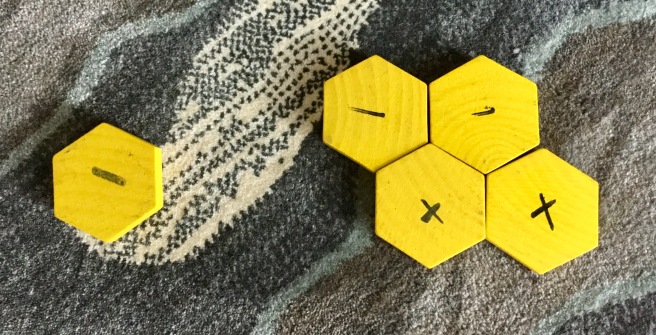
One.
Little.
Picture.
Hmm. If you broke up the four hexagons into triangles could you rearrange to make a big hexagon?
Great investigation.
LikeLike
Totally could, maybe even include some trapezoids. I was curious about using only hexagons, and that impossibility pushed me (or my students) to wonder why and dig deeper, which I love.
LikeLike
Love your post. This is exactly the culture I strive to create. Great to find more like minded people.
LikeLike
Great to be found!
Thank YOU for the inspirational image. These are the musings that make me wish I had a classroom again.
LikeLike
Thank you so much for this post! I loved listening in on your mathematical play. I’m dying to go get my pattern blocks now. 🙂
Any chance we could get you on math teacher twitter? I’d love to learn from you and your OMG, WTF, and AHA moments there too. It’s a playful space.
Best,
Tracy
LikeLike
Thank you so much for your comment! Um…I don’t “get” twitter, but I have two sisters (both teachers) who do, so I can ask them to explain yet again.
LikeLike
I loved this post! It surprised me, and made me excited in a good math-y way. We can help with twitter!
LikeLike
Me, too! I am going to need help with twitter…I don’t even know exactly what to ask. (I blogged about that, too!)
LikeLike
Start with making the account! My twitter tag is @TAnnalet. #mtbos is a general “meeting place”. Other hashtags and chats you will discover in the process. Oh, add your blog address to your profile.=)
LikeLike
Also you can find Tracy at @TracyZager, Simon at @Simon_Gregg, John at @mathhombre, Amie at @nomad_penguin, Sara at @Saravdwerf, Mark at @MarkChubb3. Say hi, join a conversation or start a new one.
LikeLike
Yes, Twitter, that’s whatbrought me to your great post (thank you Mr Golden).
I love pattern blocks and use them a lot with the young children I teach.
I also think that thing about how all 2D shapes scale really makes sense of how Pythagoras works. See my post http://seekecho.blogspot.com/2014/05/the-proof-see.html
LikeLike
Great post! Love that one little picture can bring about so much play and discovery!
You basically captured the afternoon we had when we actually took the picture you used here (well, almost).
Keep on writing and sharing!
LikeLike
I loved your post; thank you! By coincidence, I used this image with my pre-service teachers last week as an opportunity to ‘Notice and Wonder’. If you are interested, I’ll collect their observations together somewhere and share.
LikeLike
So glad your pre-service teachers are getting the opportunity to Notice and Wonder and to experience math learning in a way that is most likely different than what they grew up with. Yes, I am interested.
LikeLiked by 1 person
I’ve written a quick post here: https://amiealbrecht.com/2017/08/15/a-serendipitous-pythagorean-lessonstarter/
LikeLike
Thanks for sharing how you used this image. So many possibilities, it blows my mind.
LikeLike